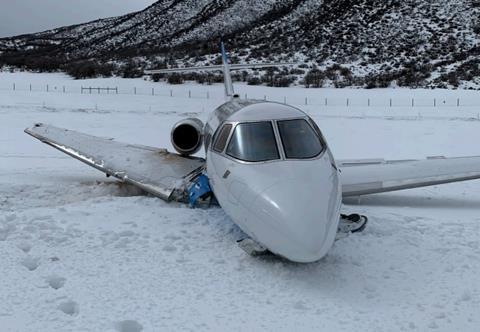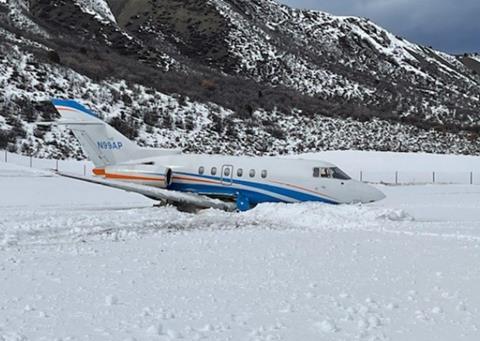Investigators have determined that a departing Raytheon Hawker 800XP overran after failing to rotate, after the crew attempted to take off in a tailwind which exceeded limitations.
The aircraft had lined up on runway 33 at Colorado’s Aspen-Pitkin County airport, for a cross-country flight, on 21 February 2022.
Weather information over the ATIS information service indicated winds from 170° at 18kt, gusting to 30kt.
The crew had deployed 15° of flap to reduce the take-off distance.
After a delay for arriving traffic, the Hawker was cleared for take-off with winds from 160° at 16kt, gusting to 25kt. This would have indicated a tailwind component close to these wind speeds, whereas the Hawker’s maximum tailwind limitation for take-off was just 10kt.
The tower controller, in an unsolicited remark, also mentioned an “instantaneous” wind from 180° at 10kt.
Although it was used by the airport’s tower, and a few operators familiar with the airport, this ambiguous term is not defined in any US FAA publication. According to the US National Transportation Safety Board, the airport’s air traffic manager was unsure where it had originated.
Despite multiple wind reports over the previous 30min consistently indicating a strong tailwind, the Hawker crew interpreted the ‘instantaneous’ wind level of 10kt as falling within limits.

The aircraft accelerated to its rotation speed of 121kt but, when the captain applied back-pressure on the control yoke, the jet would not rotate.
After a few seconds the captain realised the aircraft would not become airborne, and aborted the take-off, throttling back to idle, braking and deploying the thrust-reversers.
This was insufficient to stop the jet on the runway, which had a length of just over 8,000ft, and it overran into snow. The impact caused the right wing to break away from the fuselage and the aircraft came to rest with substantial damage.
None of the occupants – two pilots and four passengers – was injured.
“It is very likely that the airspeed did not reach [rotation level] due to tailwind conditions that exceeded the [aircraft’s] maximum tailwind limitation,” the inquiry says.

But investigators have not been able to reach a complete understanding of the circumstances. The Hawker (N99AP) was not fitted with a flight-data recorder which could have captured airspeed information.
Performance analysis was carried out using ADS-B groundspeed data to calculate airspeeds under different wind conditions.
This found that the jet achieved a maximum groundspeed of 165kt, and that a wind from 180° would need to reach 35kt to reduce the airspeed below the computed rotation speed of 121kt. But under certification rules, the aircraft should still have been able to lift off at an airspeed of 110kt.
The conclusion that the crew should have had sufficient air load to rotate is inconsistent with the crew’s account that the yoke did not have any air resistance when pulled back – especially given that investigators discovered no problems with the flight controls.
“These discrepancies could not be resolved with the available evidence,” says the inquiry.
Crews have since been instructed by the aircraft operator not to use ‘instantaneous’ wind reports for decision-making.


























